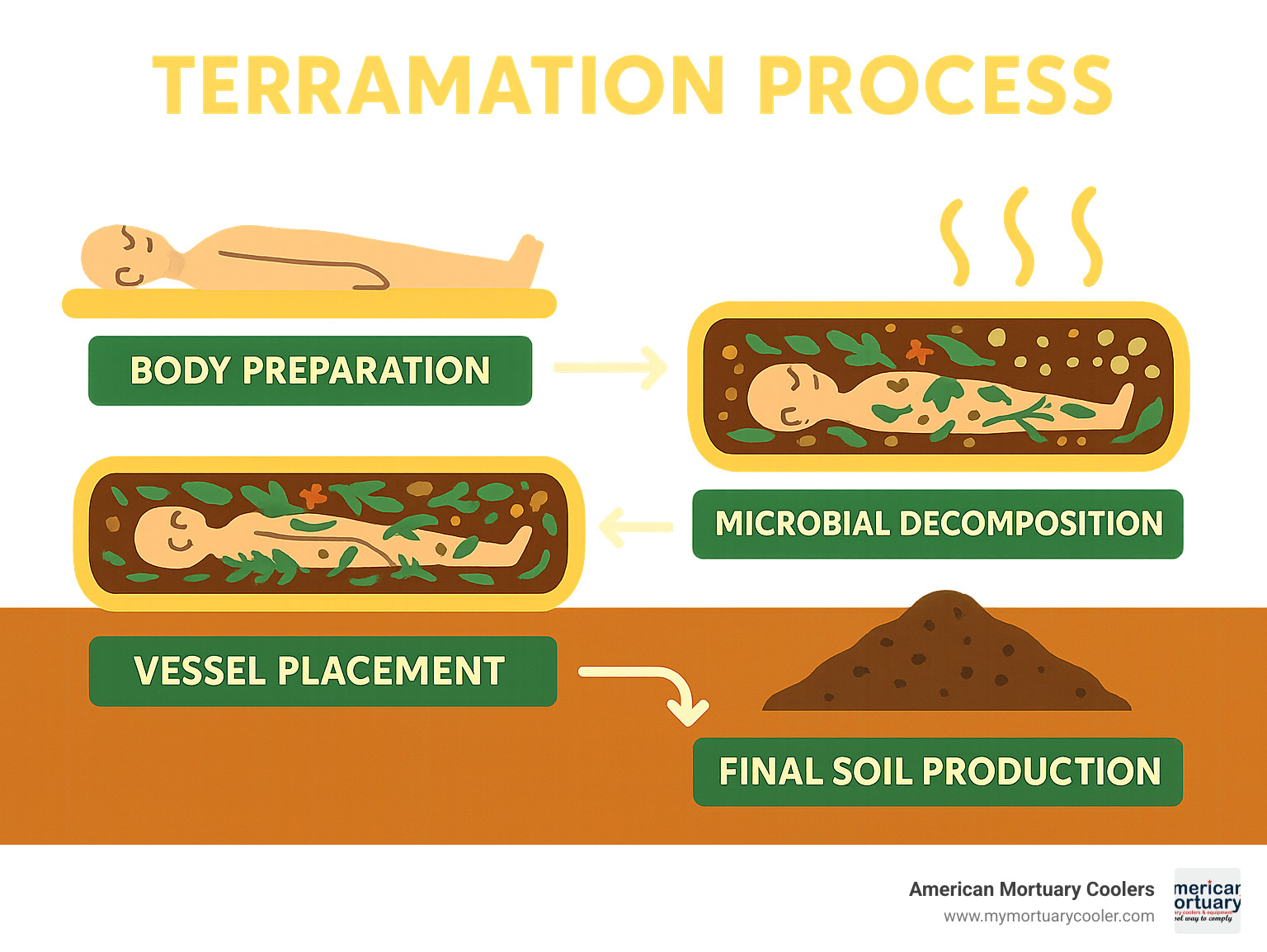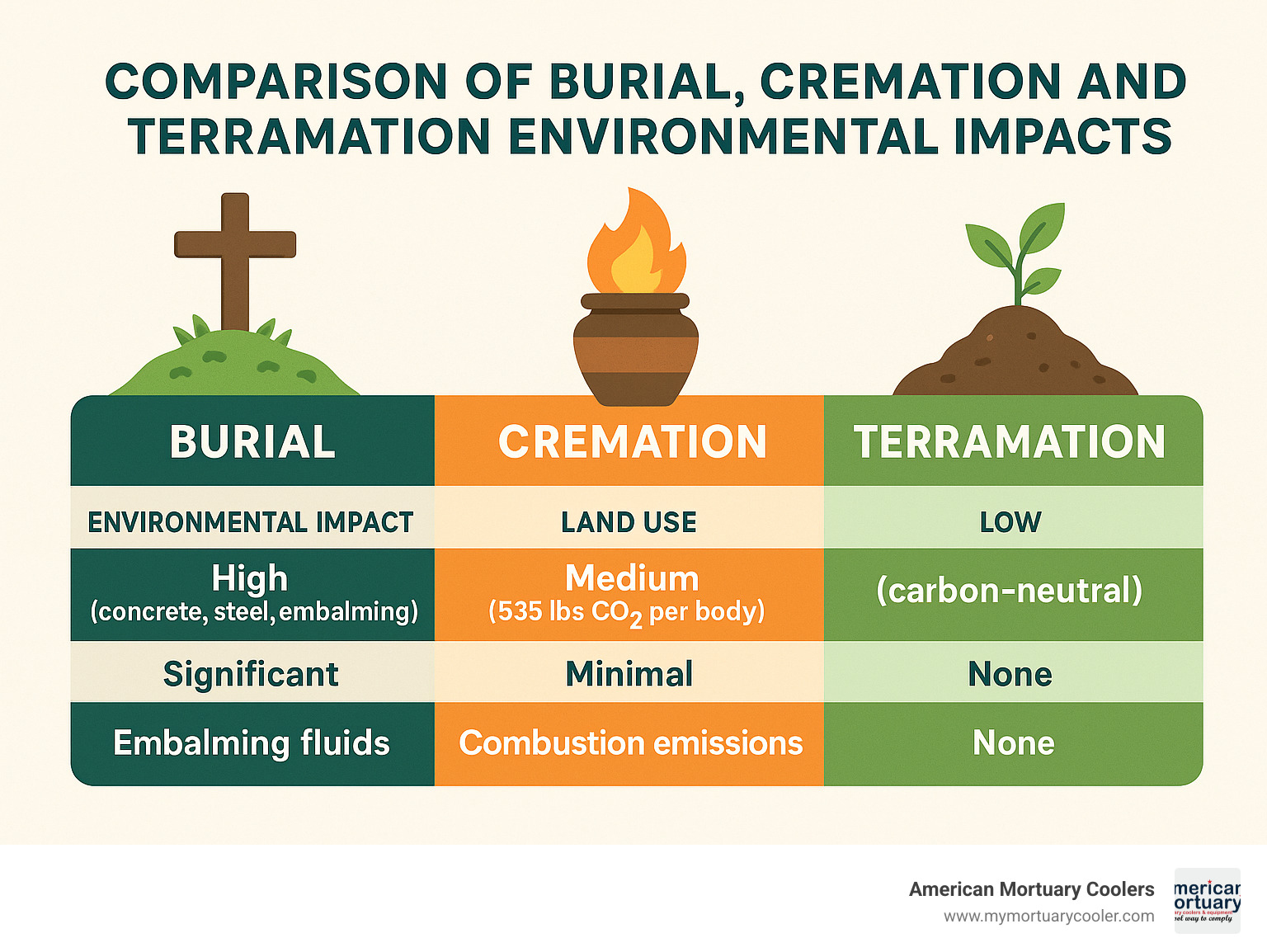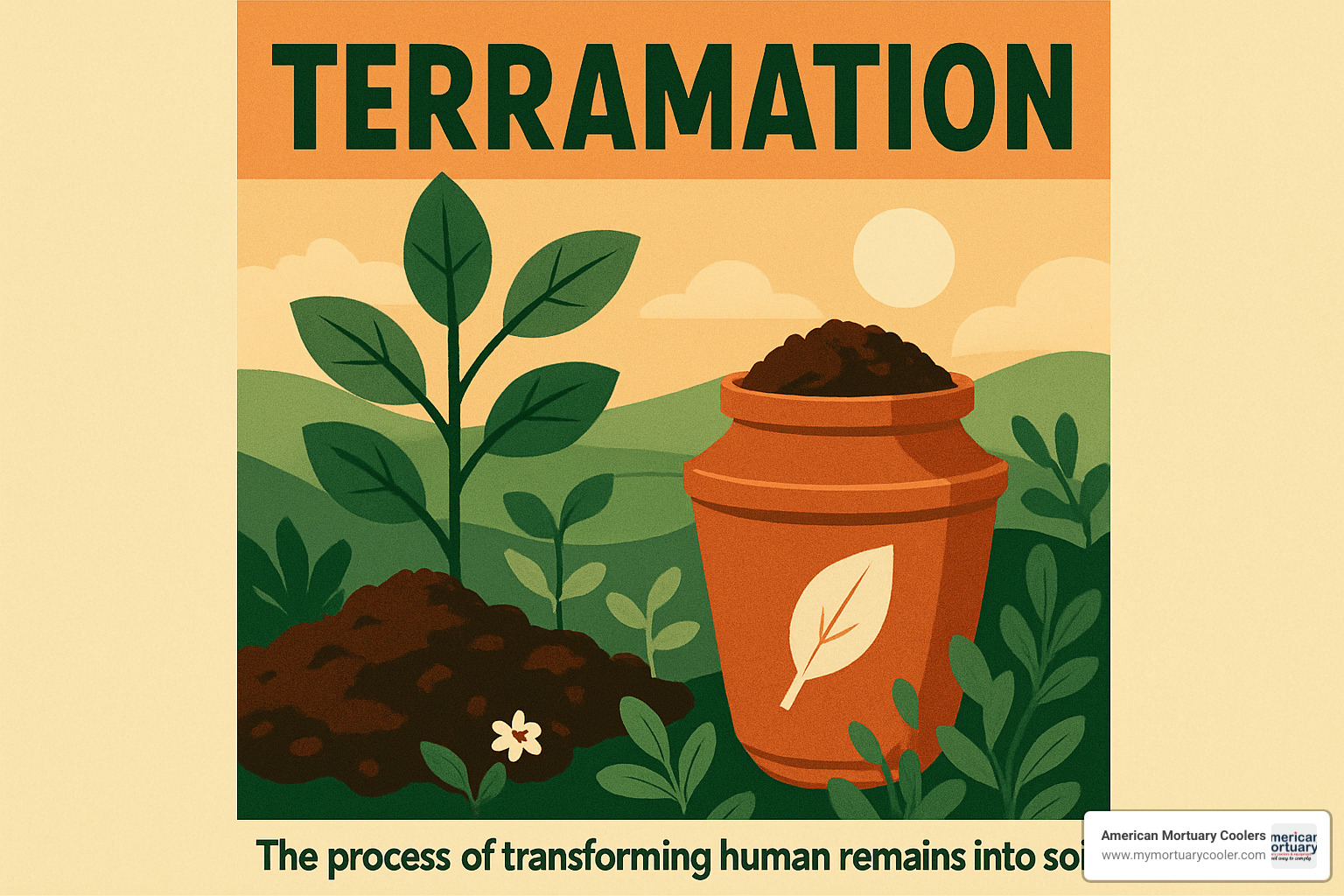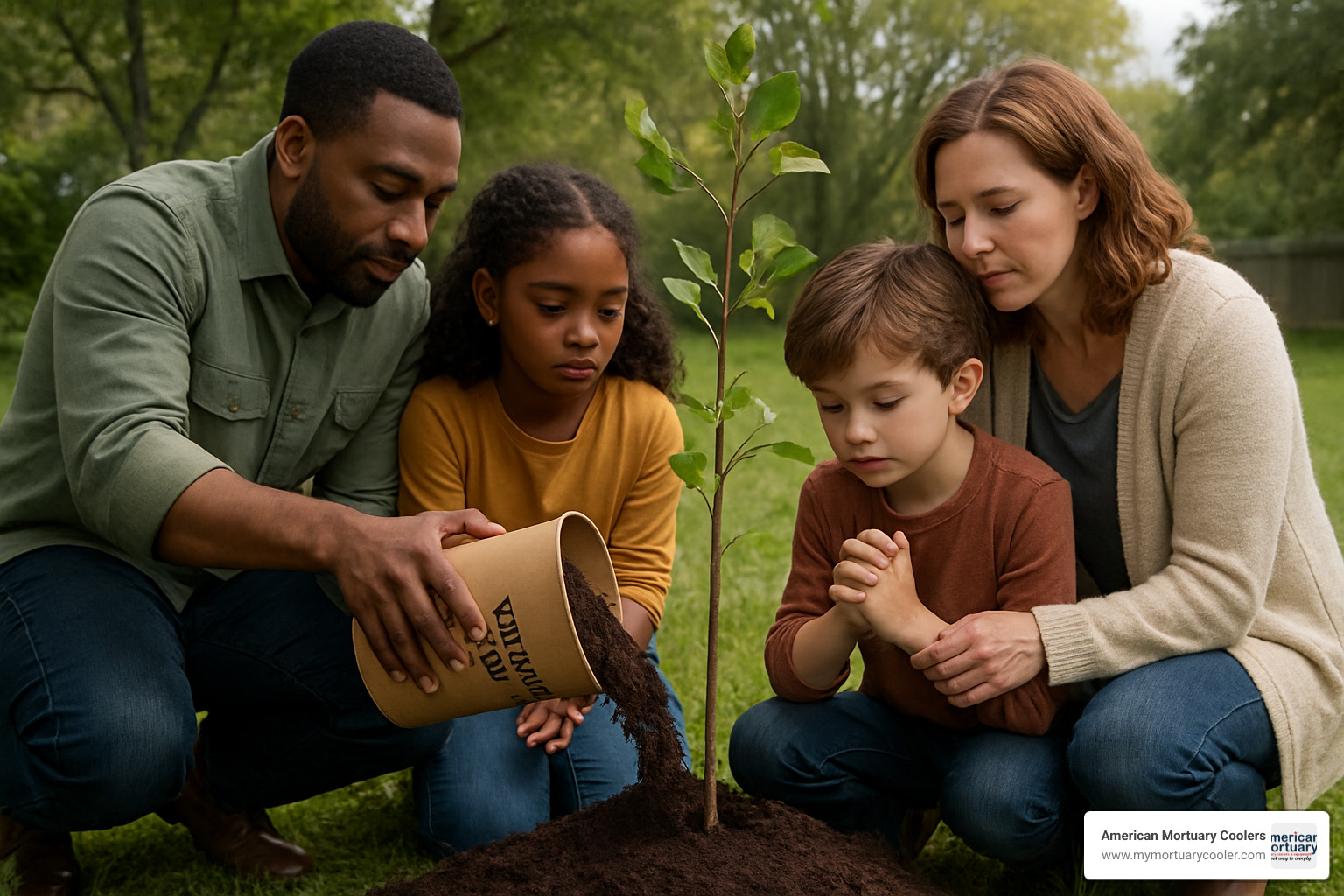Understanding Terramation: A Natural Return to Earth
Terramation is a gentle process that transforms human remains into nutrient-rich soil using natural decomposition. For funeral directors seeking sustainable options for their clients, here's what you need to know:
- Definition: A body composting process that converts human remains into soil using organic materials
- Timeline: Takes approximately 30-45 days for active decomposition, followed by a 30-day resting period
- End Result: Produces about one cubic yard (200-300 pounds) of nutrient-rich soil
- Cost: Ranges from just under $5,000 to just over $7,000
- Environmental Impact: Carbon-neutral alternative to cremation (which releases 535 lbs of CO2)
- Legal Status: Currently legal in 12 US states including Washington, Oregon, Colorado, and New York
The demand for green funeral options is growing rapidly, with the National Funeral Directors Association reporting that more than 60% of people are interested in exploring environmentally friendly end-of-life choices. As climate concerns intensify, terramation offers funeral homes a meaningful alternative that aligns with many families' values and wishes.
Unlike traditional burial, which uses precious land and often involves embalming chemicals, or cremation, which requires significant energy and produces emissions, terramation works with nature's processes to return a body to the earth in its most beneficial form.
I'm with American Mortuary Cooler, a national-level mortuary cooler supplier with extensive experience supporting funeral homes implementing terramation services through proper body storage solutions. Our work with facilities across states where terramation is legal has given us unique insights into the practical aspects of this growing trend.

Why This Guide Matters
With the growing demand for green funeral options, understanding terramation is becoming increasingly important for both funeral professionals and families. The climate impact of traditional funeral practices is significant—a single cremation releases about 535 pounds of CO2, equivalent to a 609-mile car drive. Meanwhile, conventional burials place millions of gallons of embalming fluid and tons of steel, concrete, and hardwood into the ground annually.
This guide focuses on beginners—whether you're a funeral director looking to expand your service offerings, a family considering options for a loved one, or someone planning ahead for your own end-of-life arrangements. We'll walk you through everything you need to know about this innovative and eco-conscious approach to death care.
Terramation 101: Definition, History & Key Terms
When we return to the earth, we can now do so in the most literal sense. Terramation offers exactly that—a return to soil through natural processes. This gentle method (also called natural organic reduction or NOR) places a body in a vessel with organic materials like wood chips, straw, and alfalfa. These materials create the perfect environment for nature's recyclers—microbes—to transform human remains into rich, life-giving soil.
The story of modern terramation began in Washington State, which pioneered legislation in 2019 through Senate Bill 5001. This groundbreaking law made Washington the first state to legalize what they officially termed "natural organic reduction." The concept wasn't entirely new—it builds on the same principles that break down fallen trees in forests—but its application to human death care certainly was.
The word "terramation" itself tells a beautiful story—combining "terra" (earth) and "mation" (creation) to literally mean "creating earth." This thoughtful term offers a more dignified alternative to "human composting," which some find too agricultural or clinical. The science behind the process is fascinating, relying on thermophilic (heat-loving) microbes that thrive in the carefully maintained vessel environment. Scientific research on microbial decomposition confirms the safety and effectiveness of this approach.
Terramation vs. Human Composting—Same or Different?
If you're confused by the different terms, you're not alone. Terramation and human composting are identical processes—just different names for the same thing. The legal documents typically use "natural organic reduction," while "recomposition" and "body composting" appear in various contexts too.
Many providers prefer "terramation" because it better honors the profound change taking place. The terminology continues to evolve as more people accept this option, but rest assured—whatever term you encounter, the process remains the same: a natural return to soil that completes life's cycle.
Key Vocabulary You'll See on Your Journey
As you explore terramation, you'll encounter some special terms that help describe this unique process:
The laying-in ceremony marks the beginning, when family members can participate in placing their loved one in the vessel—often adding flowers, notes, or other biodegradable mementos. The vessel itself varies by provider but creates the enclosed space where change happens.
During the resting phase—a 30-day period following active decomposition—the soil stabilizes and matures. Some families choose WISPs (Wholly Integrated Shrouding Products), which are fully compostable garments specifically designed for terramation.
You might hear providers refer to the process as soil change, highlighting the transformative nature of this option. Before completion, screening removes any non-organic materials from the finished soil, ensuring what's returned to families is pure and usable.
For funeral directors looking to expand their offerings, understanding this vocabulary helps provide clear, compassionate guidance to families considering this earth-friendly option. More info about terminology can help you become fluent in this evolving field.
How Terramation Works: Step-by-Step Process
The journey of terramation unfolds through a thoughtful, natural sequence that honors both the deceased and our planet. This remarkable change happens not in a single moment, but through several carefully managed phases.
When a body begins its terramation journey, it's first gently washed and dressed in fully biodegradable clothing or wrapped in a simple natural shroud. Nothing artificial remains that could interrupt nature's process. The body then finds its temporary home in a specially designed vessel – think of it as a cocoon for change – nestled among organic materials like wood chips, straw, alfalfa, and sometimes delicate wildflowers.
For the next 30-45 days, nature takes the lead. Naturally occurring microbes – the same tiny organisms that break down fallen leaves in forests – begin their important work in an environment carefully calibrated for optimal temperature, moisture, and oxygen levels. This active decomposition phase is where the most dramatic changes occur.

During this time, temperatures naturally rise to between 131-150°F (55-65°C) as the microbes work – warm enough to accelerate the process and eliminate pathogens, but still gentle in its approach. Technicians periodically turn the materials, much like tending a garden, ensuring even decomposition and maintaining those crucial aerobic conditions that prevent odors and promote efficient change.
When the active phase completes, the resulting material passes through a careful screening process to remove any non-organic items like metal implants (which are typically recycled). Bones, which nature takes longer to break down, are respectfully processed into a fine powder and reintroduced into the soil. The result is approximately one cubic yard (200-300 pounds) of rich, life-giving soil.
This soil isn't quite ready yet – it enters a 30-day resting phase, cooling and stabilizing before completing its journey.
Preparation & "Laying-In" Ceremony
Perhaps the most touching aspect of terramation is the "laying-in" ceremony, where families can participate in this meaningful transition. Unlike traditional options that often separate families from natural processes, this ceremony invites connection and participation.
Many families choose to place flowers alongside their loved one. Others include handwritten notes or biodegradable mementos. Some find comfort in helping to cover the body with the organic materials themselves – a final act of care and tenderness that many describe as surprisingly healing.
The beauty of this ceremony lies in its flexibility. Some families incorporate religious elements that honor their traditions. Others include music, readings, or storytelling that celebrates the person's life. Whether simple or elaborate, in-person or virtual, this meaningful ritual provides both closure and a sense of participation in the natural cycle of life.
Terramation Change (Primary Keyword)
The terramation change itself happens over those critical 30-45 days as microbes do what they've done in nature for billions of years – transform organic matter into soil. The difference here is the carefully optimized environment that respectfully accelerates what would happen naturally.
Throughout this phase, technicians monitor the process with attention to detail. They maintain the perfect moisture balance – not too wet (which could create anaerobic conditions and unwanted odors) and not too dry (which would slow the microbes' activity). Advanced odor control systems ensure the facility remains pleasant and respectful.
The vessels themselves rest in dedicated spaces with proper ventilation and environmental controls. Though hidden from view during this time, the change occurring inside represents one of nature's most fundamental processes – the conversion of life into the building blocks for new life.
Screening, Resting & Soil Return
Once active decomposition completes, the soil enters its final stages of preparation. After careful screening to remove any non-organic materials, the soil rests for 30 days, stabilizing and cooling. During this time, it undergoes testing to ensure it meets all safety standards and is free of pathogens.
When the soil is ready, families face a meaningful choice. They can receive all or part of the soil (approximately one cubic yard) for personal use. Many create living memorials by planting memorial trees or gardens that continue to grow and flourish. Others find comfort in scattering the soil in places that held special meaning to their loved one.
Alternatively, families can donate the soil to conservation efforts or restoration projects, allowing their loved one to contribute to environmental healing. Many choose a combination – keeping a meaningful portion while donating the rest to nurture public lands or forests.
This final stage transforms grief into growth, offering families tangible ways to honor their loved one's legacy while contributing to the health of our planet – a truly beautiful conclusion to the terramation journey.
Why Choose Terramation? Environmental, Economic & Spiritual Upsides
Terramation offers compelling advantages over traditional burial and cremation, making it an increasingly attractive choice for those looking to leave a gentler footprint on our planet when they depart.

When we look at the numbers side by side, the benefits become clear. Traditional burial typically costs around $7,848 (not including the cemetery plot, headstone, or vault) and uses significant land while introducing embalming chemicals into the soil. Cremation, while requiring minimal land, still produces about 535 pounds of CO₂ per body and costs around $6,970 for a service with viewing.
Terramation, by contrast, ranges from $5,000-$7,000, uses no land permanently, and introduces no harmful chemicals into our environment. It's a truly carbon-neutral option that aligns with many families' values and budget needs.
| Method | Environmental Impact | Average Cost | Land Use | Chemical Use |
|---|---|---|---|---|
| Traditional Burial | High (concrete, steel, embalming) | $7,848+ | Significant | Embalming fluids |
| Cremation | Medium (535 lbs CO₂ per body) | $6,970 | Minimal | Combustion emissions |
| Terramation | Low (carbon-neutral) | $5,000-$7,000 | None | None |
Environmental Benefits at a Glance
The earth-friendly aspects of terramation go beyond just avoiding harm—this process actively contributes to healing our planet.
Unlike cremation's 535 pounds of carbon emissions (equivalent to a 609-mile car trip), terramation is essentially carbon-neutral. The process skips the toxic embalming chemicals that can eventually seep into groundwater from traditional burials. And instead of permanently claiming a plot of land in an ever-expanding cemetery, terramation actually creates something beautiful: nutrient-rich soil that can nourish new life.
Consider the scale: with 2.8 million deaths annually in the U.S., traditional burials consume massive amounts of hardwood, steel, copper, bronze, and concrete. Terramation uses only renewable materials and gives back to the earth rather than taking from it.
Many terramation providers have formed meaningful partnerships with conservation organizations, allowing families to donate their loved one's soil to ecosystem restoration projects. This creates a beautiful legacy where a person continues to contribute to environmental healing even after death. The soil created can help sequester carbon, restore depleted landscapes, and support biodiversity—truly a gift that keeps giving.
Wallet-Friendly Without Sacrificing Meaning
Terramation manages to be gentle on both the planet and your wallet. At $5,000-$7,000, it typically costs less than traditional options while providing a meaningful, dignified process. Many providers understand that end-of-life expenses can be challenging and offer community funds or sliding-scale pricing to ensure this option remains accessible to those with financial constraints.
The standard pricing usually covers everything you need: transportation, the entire change process, and return of the soil to families. There are no hidden costs for cemetery plots, vaults, or expensive caskets, making financial planning more straightforward during an already difficult time.
From a spiritual perspective, many people find profound meaning in literally returning to the earth and nurturing new life. There's something deeply comforting about the idea of becoming part of a garden, a forest, or a beautiful landscape. While the biblical notion of "dust to dust" or "ashes to ashes" takes on a new, literal meaning with terramation, religious perspectives do vary.
Catholic officials have generally expressed reservations about the process, citing concerns about respect for the body. However, some Catholic theologians see terramation as consistent with natural decomposition and the church's growing emphasis on environmental stewardship. Similarly, Orthodox Jewish authorities have raised concerns, while Reform and Conservative Jewish perspectives show more variation in acceptance.
For many families, terramation represents a meaningful way to honor both their loved one and the planet that sustained them throughout life—a final act of giving back that creates beauty from loss. As one family member put it after participating in a laying-in ceremony, "It felt like the most natural thing in the world, returning her to the earth she loved so much."
Legal Status, Accessibility & Leading Providers
The landscape for terramation is expanding rapidly across America. As of 2024, this gentle return-to-earth option is legally available in 12 U.S. states:
- Washington (effective May 2020)
- Oregon (effective January 2022)
- Colorado (effective August 2021)
- Vermont (effective January 2023)
- California (effective 2027)
- New York (awaiting regulatory implementation)
- Nevada (effective January 2024)
- Maine (effective June 2024)
- Minnesota (effective 2025)
- Maryland
- Delaware
- Arizona

The momentum is building, with several additional states considering similar legislation. Each state that approves terramation establishes its own regulatory framework, typically requiring providers to secure proper licensing through state funeral regulatory boards. This careful oversight ensures the process remains dignified, safe, and environmentally sound.
Where Terramation Is Legal in 2024
Washington State blazed the trail in 2019, becoming the first to legalize terramation, with the first facilities welcoming families in 2020. This pioneering move opened doors for other forward-thinking states to follow suit.
Some states have taken a measured approach to implementation. California's legislation, for instance, includes a 2027 effective date, allowing time to develop thoughtful regulations. Minnesota's law activates in 2025, while New York has approved the practice but continues refining its regulatory framework.
The legal status of terramation is evolving month by month. Funeral directors should stay connected with their state funeral boards for the most current information, or follow updates from advocacy organizations dedicated to expanding access to this earth-friendly option.
Getting Access If Your State Isn't On The List
Living in a state where terramation isn't yet legal doesn't mean this option is off the table. Many families choose to transport their loved ones across state lines to facilities where the practice is permitted.
This interstate journey typically follows three steps:
- A local funeral home prepares and properly refrigerates the body.
- Transport to a terramation facility in a neighboring legal state is arranged.
- The resulting soil is shipped back to the family.
This process requires careful coordination between funeral homes in both states. Proper refrigeration during transport is absolutely essential—this is where specialized equipment from companies like American Mortuary Coolers plays a vital role in maintaining dignity and safety during the journey.
Choosing a Provider & What Differs Between Them
A growing number of licensed funeral establishments now offer terramation. While every provider follows the same core scientific principles, their services can differ in meaningful ways:
- Timeline: Some facilities complete the process in about 30 days, while others take 45–60 days to ensure complete change.
- Family participation: Opportunities for involvement in the laying-in ceremony, virtual viewing, or final soil pickup vary.
- Facility philosophy: Certain providers emphasize renewable energy use, carbon-offset programs, or conservation partnerships for soil donations.
- Setting: Options range from contemporary urban environments to rustic, forest-adjacent campuses.
- Pricing models: Most fall within the $5,000–$7,000 range, though sliding-scale or community funds may be available.
When helping families choose a provider, encourage them to ask about these variables so they can select the experience that best matches their budget, timeline, and values.
Pre-Planning & Family Participation
Pre-planning for terramation follows similar principles to pre-planning other funeral arrangements, with some specific considerations.

Simple Steps to Pre-Plan a Terramation Service
Research providers: Identify facilities in your state or region that offer terramation.
Contact the provider directly: Most offer pre-planning consultations to explain their specific process and options.
Complete the necessary paperwork: This typically includes authorization forms and preference documentation.
Consider payment options: Many providers offer pre-payment plans or accept assignment of insurance benefits.
Document your wishes: Ensure your family and executor understand your preference for terramation by including it in your will, advance directive, or pre-need funeral contract.
Decide on soil destination: Determine whether you want your soil returned to family, donated to conservation efforts, or a combination.
Plan any accompanying ceremonies: Consider whether you want a traditional funeral service, memorial, or laying-in ceremony to accompany the terramation.
For funeral directors, offering pre-planning for terramation can be a valuable service, particularly as awareness and interest in this option continues to grow.
Creative Ways to Use Returned Soil
Families who choose terramation often find meaningful ways to use the resulting soil:
Memorial gardens: Creating dedicated spaces where the soil nourishes flowers, vegetables, or other plants
Tree planting: Using the soil to plant trees that can grow for generations
Conservation donations: Contributing to reforestation, habitat restoration, or sustainable agriculture
Dividing among family members: Allowing multiple loved ones to create their own living memorials
Combining with other memorialization: Some families keep a small portion of soil in a decorative container while using the rest for planting
Some families even combine terramation soil with memorial items like the "mushroom suit"—a biodegradable burial garment embedded with mushroom spores that aid decomposition and detoxify soil. While the mushroom suit is designed for green burial, its principles align well with the philosophy behind terramation.
Frequently Asked Questions About Terramation
What Happens to Implants, Bones & Non-Organic Materials?
One of the most common questions families ask about terramation concerns what happens to the parts of our bodies that don't naturally decompose.
Metal implants like pacemakers, hip replacements, and dental work remain intact throughout the process. These materials are carefully removed during the screening phase—think of it as a gentle sifting process that separates these items from the soil. Most providers have established relationships with metal recycling facilities and will ensure these items are responsibly recycled according to environmental and ethical guidelines.
Bones tell a different story. While they do decompose during terramation, they break down more slowly than soft tissues. The process eventually transforms them into a fine, powder-like consistency through a combination of natural microbial action and gentle mechanical processing. Far from being discarded, this bone material actually enriches the final soil with valuable minerals like calcium and phosphorus—nutrients that will nourish future plant life.
As for personal items like wedding rings or cherished jewelry, these are typically removed before the process begins and returned to the family, just as they would be with traditional burial or cremation options. If you have specific concerns about particular implants or items, most providers are happy to discuss how they'll be handled.
How Much Soil Will We Receive and How Can We Use It?
The change of a loved one through terramation typically yields about one cubic yard of soil—that's roughly 200-300 pounds, or enough to fill 3-4 wheelbarrows. It's a substantial amount that offers families numerous possibilities for meaningful use.
You're never obligated to take all the soil. Many families choose to receive just a portion while donating the rest. The soil itself is perfectly safe for any purpose you might imagine—there are no legal restrictions on how you can use it.
Many families find comfort in using the soil to create living memorials. Some plant memorial trees that will grow for generations, while others create dedicated garden spaces where the nutrients nourish beautiful flowers or even vegetables. Some families divide the soil among relatives so each person can create their own tribute, while others scatter it in places that held special meaning to their loved one (where permitted by local regulations).
For those who want just a symbolic amount, most terramation providers offer special containers that hold a small portion, while the remainder can be donated to conservation efforts or restoration projects. The soil typically arrives in simple, biodegradable bags or containers, ready for whatever purpose you choose.
Can I Still Hold a Traditional Funeral Service Before Terramation?
Terramation fits beautifully into existing funeral traditions. You can absolutely hold any type of funeral service before the terramation process begins, including traditional viewings, religious ceremonies, celebrations of life, or intimate home funerals.
The only significant consideration is embalming. Since traditional embalming chemicals can interfere with the natural decomposition process and introduce toxins into the resulting soil, it's generally not recommended before terramation. But this doesn't mean you can't have a viewing or service with the body present.
Proper refrigeration is the key alternative that allows for meaningful gatherings while preserving the body naturally. This is where specialized equipment from companies like American Mortuary Coolers becomes essential—our refrigeration units can preserve the body for several days, providing ample time for services before the terramation process begins.
Many families also choose to hold a second ceremony after the process is complete. These often take the form of tree planting ceremonies or garden dedications using the returned soil, creating a powerful symbol of continuing life and renewal.
If you're planning a service before terramation, your funeral director can help coordinate the timing between the service, transportation, and the beginning of the terramation process to ensure everything flows smoothly for your family.
Conclusion
Terramation represents a beautiful innovation in sustainable death care—one that honors both our loved ones and the planet we all share. By working with nature's processes rather than against them, it offers a meaningful alternative that many families find deeply comforting.
As awareness spreads and more states legalize this option, we're seeing terramation become an increasingly common choice. The numbers tell the story—over 60% of Americans now express interest in green funeral options, so this trend is clearly more than a passing fad.
For those who cherish our natural world, the environmental benefits are profound. Instead of consuming resources or releasing carbon, terramation creates new life-giving soil that can nourish gardens, forests, and conservation lands for generations to come. It's a final act that transforms ending into beginning.
At American Mortuary Coolers, we're proud to support this emerging option. Our custom refrigeration solutions help funeral homes safely preserve and transport bodies to terramation facilities, particularly important for families in states where the service isn't yet locally available. We focus on ensuring the body is properly preserved during the critical pre-process period.
The choice of how we return to the earth is among the most meaningful decisions we make. By choosing terramation, many find comfort in knowing their final act creates something beautiful—nutrient-rich soil that can support new growth, new life, and a healthier planet.
For more comprehensive information about human composting options across the country, you might find our guide to human composting options helpful in your research.



















